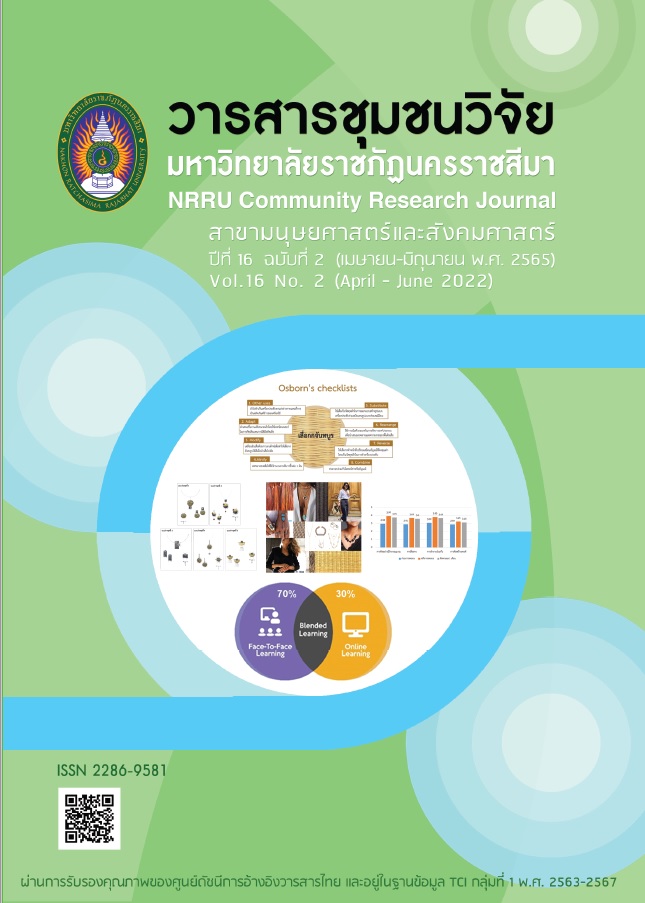POLITICAL INSTALLATION: APPROACHES TO THE ANALYSIS OF THE SOCIAL FORMATION OF “KHANA RATSADON” (THE PEOPLE’S PARTY)
DOI:
https://doi.org/10.14456/nrru-rdi.2022.21Keywords:
Siamese regime change of 1932, Khana ratsadon (The people’s party), Political installation, Historical blocAbstract
This article aims to study and analyze the issues related to the changes after The Siamese Regime Change in 1932 by proposing a theoretical explanation along with historical facts, especially in the dimensions of the social formation of Khana Ratsadon (the People's Party). The author uses the concept of “political installation” as a tool to seek knowledge and create new explanations. The results of previous studies were explained by the fact that in the past there have been four ways of studying guidelines that were compiled roughly in order to expand the body of knowledge of such educational issues. For this study, the author proposed a fifth way of studying the guidelines. By calling such a group “a group of works that focus on the process of the struggle for political power”, the study found that the political formation of the People's Party gathered members from many powerful groups that had different social status, social power and political ideology in Siam. Nevertheless, they were united under the same common wills and interests to operate and struggle to become the Hegemony group or the dominant force in political society that formed a large historical bloc. After their success in seizing power, rifts and strife between the various factions in the People’s Party started to emerge. These rifts caused the transformation of small groups within the Party, but the structural integrity remained in the larger holistic political movement.
References
Banomyong, P. (1999). Eeconomic outline Luang Pradit Manutham (Pridi Banomyong). Bangkok : Children's Foundation Publishing House. (In Thai)
Banomyong, P. (2000). Protect the spirit of complete democracy of the heroes 14 October (5th ed.). Bangkok : Saitan. (In Thai)
Banomyong, P. (2009). The concept of democracy of Pridi Banomyong. Bangkok : Sukkapapjai. (In Thai)
Banomyong, P. (2014). Something about the founding of the People's Party and the democratic system. Behind the 1932 Revolution (8th ed.). Bangkok : Chonniyom. (In Thai)
Buddharaksa, W. (2014). A Survey of Gramsci's Political Thought. Bangkok : Sommot. (In Thai)
Buddharaksa, W. (2018). Gramsci and Political Installation: Philosophy of Praxis, Social Transformation, and Human Emancipation. Bangkok : Sommot. (In Thai)
Chaiching, N. (2013). Khofanfainaifananlueachuea : Movement of the counter-revolutionary movement of Siam (B.E.1932-1957). Bangkok : Matichonbook. (In Thai)
Fuwongcharoen, P. (2016). The Revolution of 1932 in the view of an “outsider”, a diplomatic document on Siam after the regime change. King Prajadhipok's Institute Journal, (January-April 2016), 47-62 (In Thai)
Gramsci, A. (1971). Selections from the Prison Notebooks, ed. Quintin Hoare and Geoffrey Nowell Smith. Trans. London: Lawrenece Wishart.
Jessop, B. (1985). Nicos Poulantzas Marxist Theory and Political Strategy. London: Macmillan.
Kaewthep, K. (1998). Studying the Mass Media with Critical Theory: Concepts and examples of research. Bangkok: Pappim. (In Thai)
Kasetsiri, C., & Petchlertanan, T. (2000). 1932 Revolution in Siam (2nd ed.). Bangkok : Project Foundation Textbook of Social Sciences and Humanities. (In Thai)
Kasetsiri, C., & Petchlertanan, T. (2004). Revolution 1932. Bangkok : Project Foundation Textbook of Social Sciences and Humanities. (In Thai)
Kitirianglarp, K. (2014). Politics of class struggle in Thailand from 1992 to 2006. Thesis, Doctor of Philosophy Program in Political Science Faculty of Political Science, Faculty of Political Science, Chulalongkorn University, Bangkok. (In Thai)
Manopimoke, W. (1977). Conflict within the People's Party. Thesis, Master of Arts Program in Department of History Graduate School, Faculty of Arts, Chulalongkorn University, Bangkok. (In Thai)
Mektrairat, N. (1982). Changes to Siam's 1932 regime: Knowledge status. Banhkok : Thai Khadi Research Institute Thammasat University. (In Thai)
Mektrairat, N. (2005). Cause of the Siam Revolution 1932. LIFE. Bangkok: openbooks. (In Thai)
Mektrairat, N. (2010). The Siamese Revolution of 1932. Bangkok : Fadeawkan. (In Thai)
Pamornmontri, P. (1974). Changes of the Regime, 1932. Thai Revolutionary Notes. Pranakorn : Charoenwit Publishers. (In Thai)
Pamornmontri, P. (1975). My life 5 land. Bangkok : Bunnakit. (In Thai)
Pitipat, S. (2019). The People's Party in the opinion of Pridi. Retrieved June 24, 2021, from https://www.nationweekend.com/index.php/columnist/10/3070?utm_source=bottom_relate&utm_medium=internal_referral (In Thai)
Pompetch, N. W. (2021). The People's Party who created the Constitution. Bangkok : Saengdao. (In Thai)
Prakitnonthakan, C. (2007). Politics and Society in Architecture: Siam, Applied Thai, Nationalism (2nd ed.). Bangkok : Matichonbook. (In Thai)
Preecha-silpakul, S. (2018). Nikhuepanithanthihanmung: The controversy about the monarchy in the organization Prepare the Constitution of Thailand from 1932-2007. Bangkok : Fadeawkan. (In Thai
Samudavanija, C., & Chantavarin, P. (1982). Basic information half a century of change Thai government. Bangkok : Jaopraya Publishers. (In Thai)
Setthabut, N., & Kasetsiri, C. (1984). Memorandum of Phraya Song Suradet When the Revolution of 24 June 1932 (2nd ed.). Bangkok : Phraewittaya. (In Thai)
Thepsongkroh, S. (2019). People's Democratic Party: Politics, Power and Memory of the (Faculty) People. Bangkok : Matichonbook. (In Thai)
Wathakan, W. (1932). Politics and Governance of Siam. Pranakorn : Thaimai. (In Thai)
Wisaprom, S. (2013). 80 years of the Siam Revolution, 1932: Consider the knowledge of the Siam Revolution of 1932. (again). Bangkok : S. Charoenkanpim. (In Thai)
Downloads
Published
How to Cite
Issue
Section
License

This work is licensed under a Creative Commons Attribution-NonCommercial-NoDerivatives 4.0 International License.




